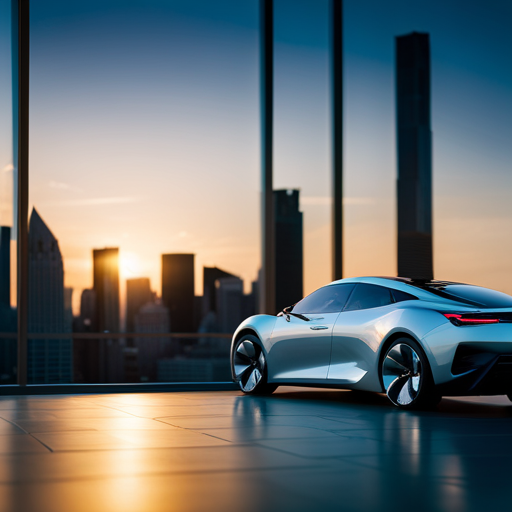The automotive industry stands on the brink of a technological revolution, profoundly altering how vehicles are designed, manufactured, and driven. Electric vehicles, once a novelty, now showcase advanced battery technologies that promise longer ranges and faster charging times. Autonomous driving systems, powered by sophisticated AI algorithms and sensor arrays, are no longer science fiction but an imminent reality. As vehicles become smarter and more interconnected, enhanced safety features and connected ecosystems are setting new standards. Additionally, sustainable manufacturing practices are aligning the industry with global environmental goals. What does this mean for the future of transportation? The implications are vast and compelling.
Key Takeaways
– Advancements in battery technology are enhancing electric vehicles’ range and charging speeds, making them a practical alternative to traditional cars.
– AI and sensor technology are driving the development of autonomous vehicles, enhancing safety and efficiency on the roads.
– IoT and V2X communication enable real-time data exchange, improving vehicle connectivity and situational awareness.
– Advanced safety features like adaptive cruise control and AEB systems are reducing accident risks and enhancing driver safety.
– Sustainable manufacturing practices are minimizing environmental impact through the use of renewable energy and resource-efficient production methods.
The Rise of Electric Vehicles
The surge in electric vehicle (EV) adoption is transforming the automotive landscape, driven by advancements in battery technology and growing environmental concerns. With lithium-ion batteries becoming more efficient, offering longer ranges and faster charging times, EVs are now a viable alternative to traditional internal combustion engine vehicles. The development of solid-state batteries promises even greater improvements, such as enhanced safety and reduced costs, making EVs more accessible to the average consumer.
Charging infrastructure is expanding rapidly, with companies and governments investing heavily in public and home-based charging stations. This expansion alleviates range anxiety, ensuring that drivers can travel longer distances with confidence. Moreover, innovations in smart grid technology and renewable energy integration are making EVs more sustainable, aligning with the global push for greener transportation solutions.
The automotive industry isn’t just witnessing a technological shift but also a cultural one. Communities of EV enthusiasts are forming, fostering a sense of belonging among like-minded individuals who share a commitment to reducing carbon footprints. As automakers continue to roll out new EV models, the trend is clear: electric vehicles aren’t only the future of transportation but also a catalyst for a more connected and eco-conscious society.
Autonomous Driving Technology
Driven by breakthroughs in artificial intelligence and sensor technology, autonomous driving is rapidly steering the automotive industry toward a future where self-driving cars become a common sight on our roads.
At the heart of this transformation lies sophisticated machine learning algorithms that enable vehicles to perceive their surroundings, make real-time decisions, and navigate complex urban landscapes.
Lidar, radar, and camera systems work in synergy to provide a detailed, 360-degree view of the environment. These sensors collect massive amounts of data, which AI processes to identify obstacles, predict the behavior of pedestrians and other vehicles, and plot safe driving paths.
The integration of Vehicle-to-Everything (V2X) communication further enhances situational awareness by allowing cars to exchange information with infrastructure and other vehicles.
Major players like Tesla, Waymo, and Uber are leading the charge, each leveraging unique technological stacks to push the boundaries of what’s possible. Their continuous testing and refinement aren’t just about achieving full autonomy but also ensuring reliability and public trust.
As these technologies advance, the societal benefits are immense: reduced traffic congestion, decreased emissions, and enhanced mobility for those unable to drive, all fostering a sense of community and connectivity.
Advanced Safety Features
As the industry races towards autonomous driving, advanced safety features are becoming the bedrock of both current and future vehicle designs, ensuring every journey is as secure as it’s innovative. These features aren’t just bells and whistles; they’re critical advancements that redefine the driving experience.
Adaptive cruise control, for instance, maintains a safe distance from the vehicle ahead, adjusting speed seamlessly. Lane-keeping assist uses cameras and sensors to prevent unintentional lane drifting, providing a layer of vigilance that human drivers might lack.
Moreover, automatic emergency braking (AEB) systems detect imminent collisions and apply brakes autonomously, often faster than human reflexes can manage. Blind-spot detection systems use radar to alert drivers of unseen vehicles, fostering safer lane changes.
Advanced driver-assistance systems (ADAS) integrate these technologies, creating a cohesive safety net that anticipates and mitigates risks.
Incorporating these features signifies a commitment to safety and innovation, resonating deeply with an audience that values security and technological prowess. As vehicles evolve, the industry’s dedication to advanced safety features builds trust and community, uniting drivers under a shared vision of a safer, smarter future on the road.
Connected Car Ecosystems
In a rapidly evolving digital landscape, connected car ecosystems are revolutionizing the way vehicles interact with their surroundings and with each other. Integrated with IoT (Internet of Things) technology, these ecosystems enable real-time data exchange between cars, infrastructure, and cloud services. This seamless connectivity enhances navigation, improves safety, and offers personalized driving experiences.
Through Vehicle-to-Everything (V2X) communication, cars can share information about road conditions, traffic patterns, and potential hazards. Drivers receive timely alerts, allowing them to make informed decisions and avoid accidents. Additionally, over-the-air (OTA) updates make sure that vehicles always have the latest software, enhancing functionality and security without a visit to the dealership.
Connected car ecosystems also facilitate advanced infotainment systems, providing drivers and passengers with access to streaming services, apps, and social media. These systems can integrate with smart home devices, allowing users to control home functions directly from their car.
Telematics plays an important role, offering insights into vehicle performance and driver behavior. Fleet managers can optimize routes, reduce fuel consumption, and improve operational efficiency. As connected car ecosystems continue to evolve, they promise to make driving safer, smarter, and more enjoyable for everyone.
Sustainable Manufacturing Practices
Moreover, markedly Automotive manufacturers are increasingly adopting sustainable practices to minimize environmental impact and enhance resource efficiency. Embracing green technologies, they’re reducing carbon footprints through advanced material science, such as lightweight composites and recycled materials. By incorporating renewable energy sources, like solar and wind, into their production lines, they’re slashing emissions and energy consumption.
Innovative water management systems are another focal point, allowing manufacturers to recycle and purify water used in processes like painting and cooling. This reduces dependency on freshwater and lessens environmental strain. Moreover, closed-loop systems in manufacturing are ensuring that waste materials are either reused or repurposed, significantly cutting down landfill contributions.
Digital twins and IoT technologies are revolutionizing production efficiency by enabling real-time monitoring and predictive maintenance, minimizing downtime and resource waste. Collaborative robots, or cobots, are also optimizing workflows, ensuring precision and reducing material wastage.
Frequently Asked Questions
How Is the Shortage of Semiconductor Chips Affecting Car Production?
The shortage of semiconductor chips is stalling car production, causing manufacturers to delay releases and reduce output. This disruption is pushing automakers to innovate and prioritize resource allocation, impacting the entire automotive community.
What Are the Latest Trends in Automotive Design Aesthetics?
The latest trends in automotive design aesthetics emphasize sleek, aerodynamic shapes, minimalist interiors, and sustainable materials. Designers are blending futuristic elements with classic lines, creating vehicles that are both cutting-edge and emotionally resonant for modern drivers.
How Are Car Dealerships Adapting to Online Sales Models?
Car dealerships are embracing online sales models by enhancing virtual showrooms, offering seamless digital transactions, and providing personalized online customer service. They’re leveraging technology to build stronger connections and foster a sense of community among buyers.
What Role Does Blockchain Play in the Automotive Supply Chain?
Blockchain improves transparency and traceability in the automotive supply chain. It guarantees authenticity and reduces fraud by securely recording transactions. Manufacturers and suppliers can now rely on the data, fostering a collaborative and efficient ecosystem.
How Is 5G Technology Enhancing Vehicle-To-Everything (V2x) Communication?
5G technology’s enhancing V2X communication by providing ultra-low latency and high-speed data transfer, enabling vehicles to interact seamlessly with each other and infrastructure, ensuring safer, more efficient driving experiences for everyone on the road.
Conclusion
To sum up, technology’s impact on the automotive industry is profound and far-reaching. Electric vehicles are gaining traction, autonomous driving is becoming a reality, and advanced safety features are enhancing protection.
Connected car ecosystems are transforming the driving experience, while sustainable manufacturing practices are setting new standards.
As IoT, AI, and renewable energy integration continue to evolve, the automotive sector is poised to deliver safer, smarter, and more sustainable vehicles, driving us into a promising future.



